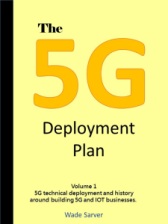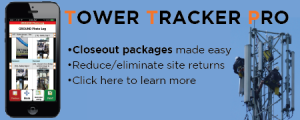Podcast: Play in new window | Download | Embed
Subscribe: Apple Podcasts | RSS
The great thing about 5G is that we will soon see private LTE networks. How is this possible? Because we finally have spectrum open to businesses everywhere. We already have license-free spectrum in 2.4GHz and 5.8GHz that we currently use for Wi-Fi. The FCC is going to allow users to use LTE in that spectrum. The issue is sharing the spectrum. It’s not efficient in public places. Where you will see it make a real difference is in your home. Suddenly when the devices have LTE, you can install a private LTE license free network in your home. That is cool.
Sign-up to get all your updates!
Now, imagine that you can build a licensed LTE network for your small business or to serve your IOT needs to for very high security on your device? You could have your device registered with an SAS company to coordinate your CBRS spectrum so that it’s your spectrum in that building, office park, or wherever. You could even use it on your smartphones when they add that spectrum to their RF boards. This is expected to happen in 2018.
Why Private LTE?
If you want a fast and reliable network, then a private LTE network is the way to go. You could improve security by going with a licensed carrier. That is why the CBRS spectrum will be a good fit. You can easily grab a lightly licensed spectrum for your personal use, and it will make your network very secure. If you need the speed and reliability that Wi-Fi may not provide, then this is a good alternative.
Why would I want a private LTE system?
The big thing now is the industrial IOT functions. This is where you may have a manufacturing plant or a warehouse where the latency and reliability are critical. This is an IOT function where IOT would make a difference, and it could change the way your machines communicate. It would be dedicated to your specific purpose.
I would like to say that your devices would have it but that is about a year away. The latest iPhone did not have this spectrum in it nor did it have the 600MHz spectrum that T-Mobile is building out now. iPhone appears behind the latest technology spectrum.
However, someday all devices will have the CBRS spectrum in them, and your device can hand off to your secure internal network and then back to the carrier’s network, in theory anyway. The idea is that we can do so much more with our devices that could be dedicated to our specific business. That is the dream that we can run our specific applications that matter to our business. Let’s say on our tablets. If you want a model, look at any scanner system for inventory, they use this now to scan everything. Imagine when we can put applications that require more bandwidth on smaller devices and take them anywhere. Our smartphone is like that now but on the carrier’s network and Wi-Fi.
Wi-Fi serves a great purpose, but security has been the issue. If we can dedicate a specific channel in the CBRS to a specific function on your smartphone, it will be very secure. It all depends on what your priority will be to achieve your networking goal. Is it easy access, security, functionality, or all 3?
What is the CBRS?
The citizens broadband Radio spectrum. This is currently specific to the United States, but it is going to open everywhere if it’s successful. US CBRS is the 3.5GHz band, which runs from 3550 to 3700 MHz band. CBRS stands for Citizens Broadband Radio Service (in remembrance of the CB, Citizens Band). It is a licensed spectrum. There is Military radar, and Earth stations that use this spectrum that is grandfathered in and have priority access. That will not change. There will be a Spectrum Allocation System (SAS). Currently in the US only, but Europe is looking to follow suit with Licensed Shared Access, (LSA).
The spectrum is 3.65GHz to 3.7GHz which was used for WiMAX. Now the FCC is opening that spectrum and an addition 150MHz spectrum for 3 types of users.
What the SAS will manage:
- incumbent access including the federal government and satellite providers.
- priority access licenses (PAL) which are 7 10MHz licenses to be awarded to the highest bidders. PALs will be protected from the GAA users. PAL will include commercial users like carriers, rural operators, are a 3-year license with only 1 renewal term allowed now, and will be in the 3500 to 3650 portion of the spectrum. One licensee can hold only 4 PAL licenses.

- general access user, (GAA) which is “Licensed by rule” which requires the rules to be followed. This will be dedicated in the 3650 to 3750 MHz portion of the band.
- A PAL may gain additional GAA spectrum.
- Companies that currently have this spectrum licenses will be able to keep their This was used for WiMAX in the past. Now it will be LTE focused.
- Licensing will be done by the Spectrum Allocation System, (SAS), which is a group that can charge for these services, currently being led by Google and Federated Wireless.
- Hardware vendors include SpiderCloud, Ruckus, Nokia, Ericsson, Samsung, ip.access, and Acceleron.
The 3 tiers are:
- Incumbent access – this is for users that are already using this spectrum for the military, ground stations, government, and so on. They will be protected.
- Priority Access Licenses (PAL) – this is for anyone who is willing to pay a premium to own 10 MHz of spectrum. The current model is for 3 years with one renewal, that could change.
- General Authorized Access (GAA) – this is for anyone who wants to use it if they have an authorized device that will connect to the SAS, Spectrum Allocation Service, and accept the assigned frequencies. You must complete a questionnaire and pay a small subscription fee, but it’s going to very reasonable.
The key here is that the SAS will coordinate all users, protect the PAL users and the incumbents.
No PAL users will be on the lower spectrum, and no GAA will be in the upper spectrum.
PAL users will most likely be the carriers or anyone who is willing to pay for dedicated spectrum for data applications, like broadband, IOT, VOIP, or anything that could be a wide area densification  project.
project.
GAA users could be for anyone in a building doing any type of LTE network. This could be private and secure coverage in a building or IOT applications or manufacturing applications that require very low latency. A private LTE network on a lightly licensed network.
A PAL can grab GAA spectrum but a GAA can’t grab PAL spectrum.
While the GAA users should not interfere with each other, it could happen, not much you can do.
All users need to comply with the FCC rules.
Your Private LTE Network
You can use the licensed or unlicensed spectrum to build your own private LTE network. This will be part of the 5G ecosystem. It could be a separate network slice, from my perspective.
You will need:
- A mini-core to control your systems and to be the interface to the internet.
- Radios that are on the band and spread throughout your little area.
- What will they control? Devices, smartphones, laptops? What will they connect?
- User Equipment which is the end user’s device. It could be a card to interface with your device if doing IOT. It could be your smartphone, which should have this spectrum in it starting in 2018. Maybe your laptop will be able to connect or have a USB interface that could connect.
Now you see that there is a way to get that private LTE network, but where do you get the parts for a CBRS network? Look at the list below:
- Ruckus makes radios and a small core.
- SpiderCloud also makes radios and a small core.
- Look to Federated Wireless to see that already have run trials, http://www.federatedwireless.com/tag/3-5-ghz/
- Any major OEM has the equipment, like Nokia, Ericsson, or Samsung, but they generally have little interest in helping a smaller business with something like that. That’s been my experience.
- As for end-user devices, I am still trying to figure that one out.
There you go, figure it out. It’s so easy a wireless guy can do it. Maybe an IT guy can do it, but who knows.
Resources:
- https://wade4wireless.com/2017/07/25/art-king-teaches-cbrs/
- https://wade4wireless.com/2017/07/31/cbrs-deep-dive-with-steve-martin/
- https://wade4wireless.com/2017/04/17/cbrs-and-the-shift-in-spectrum-ownership/
- https://wade4wireless.com/2016/04/12/cbrs-citizens-broadband-radio-service-update/
- https://blogs.cisco.com/sp/wait-for-it-wait-for-it-5g-its-here
- http://spidercloud.com/cbrs
- https://www.cbrsalliance.org/
- https://www.fcc.gov/rulemaking/12-354
- https://www.thinksmallcell.com/LTE/what-is-cbrs-shared-spectrum-for-in-building-small-cell-wireless.html
- https://www.atis.org/wsts/docs/2016/4-01_Google_Peroulas_Freq_Time_Phase_CBRS.pdf
- https://www.waterfordconsultants.com/reference-materials/CBRS_Spectrum.pdf
- https://www.qualcomm.com/invention/technologies/lte/private-lte-network
- http://www.privatemobilenetworks.com/solutions/4g-lte/
- https://www.networkworld.com/article/3179784/mobile-wireless/the-big-cbrs-promise-private-enterprise-lte-wireless-networks.html
Tower Safety and Instruction has online training and eBooks at http://teltech-college.com/ where you can get drone, tower, safety, 5G, and deployment material on your laptop! TSI, making the best better.
at http://teltech-college.com/ where you can get drone, tower, safety, 5G, and deployment material on your laptop! TSI, making the best better.
Be smart, be safe, and pay attention!
See Ya!
How do you plan goals? Now you can plan 5 Weeks at a time! The 5-week Planning Journal, (click here), available now in paperback from Amazon!
The foundations below do beautiful work, helping families in their time of need. Climbers often get seriously injured or die on the job. The foundations below support those families in their time of greatest need!
Hubble Foundation helps the families of climbers in a time of need and beyond with financial support and counseling!
Tower Family Foundation supports the families of tower climbers at the time of crisis when a climber falls with financial assistance and more.






 Putting together your smart city tech solutions, planning, development, and more….TechFecta! Guiding you to a better plan through consulting!
Putting together your smart city tech solutions, planning, development, and more….TechFecta! Guiding you to a better plan through consulting!
